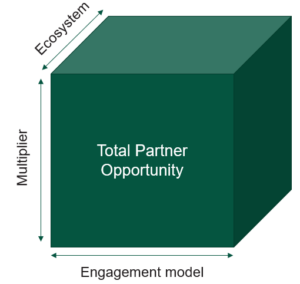Unlocking The True Business Opportunity For Modern Partners
Independent software vendors, system integrators, managed service providers, value-added resellers, application development shops, IT consultancies. We use terms like these to refer to partners, but actual partners rarely define themselves in these ways today.
In reality, modern partners are seldom limited to a single revenue stream or business model. Instead, they view a partnership as an onion with many layers of opportunities, each magnified by a complex and interconnected web of constituents adding value, co-innovating, or co-delivering solutions and outcomes to the end customer. This evolution is perhaps most evident in the traditional software resale market, where growth has slowed and margins have continued to compress over the past decade, given intensifying competition and changing buyer preferences, ultimately forcing resellers to invest in building out new practice areas and revenue streams to stay afloat. Forrester predicts that by 2025, the average channel program will have 10 times the number of partners it has today, 80% of which will be nontransacting.
The implication for vendors is clear. If future-ready partners are to adopt an ecosystem approach to doing business, they must naturally align themselves with vendors that demonstrate the ability to harness the potential of the ecosystem, bringing together its key players while providing the resources, processes, tools, and technology required to successfully build, launch, and scale new offerings. Many vendors already have these capabilities but underestimate the value that their ecosystems provide, while overestimating the value of their traditional, linear transactional channels. As vendors race to attract partner mindshare, the ability to not only create these types of opportunities but also articulate the value proposition of the ecosystem in the language of dollars and cents that partners appreciate will be increasingly critical.
The Multiplier Effect
Best-in-class vendors with robust ecosystems, including large hyperscalers and cloud service providers, are now changing the way they communicate the broader opportunity surrounding their products to their potential and existing partner networks. Instead of defining a partner by a single revenue stream, these vendors are describing the partnership opportunity as a multiplier effect in which partners can enjoy multiple revenue streams, each with compounding returns augmented by layers of value creation.
A classic example of this might be a situation in which a traditional reseller, after engaging in thousands of transactions, recognizes a consistent customer pain point, such as an inefficient billing process, and eventually builds a support arm to deliver specialized services around this issue, thereby attaching a potential downstream service contract with each resale opportunity. Later down the road, this partner may then develop an application designed to help customers manage, prioritize, and deploy these services using support tickets on an ongoing subscription basis. To demonstrate the multiplier effect using this simplified example, let’s compare the gross revenues the following fictitious partner collects using a linear approach versus a multiplier approach as it takes a customer through the engagement lifecycle over a span of three years:
| Figure 1: Annual contract value (ACV) per customer using a linear approach | |||
| Revenue stream | Year one | Year two | Year three |
| Resale margin | $10,000 | $10,000 | $10,000 |
| Professional services | |||
| App subscriptions | |||
| ACV | $10,000 | $10,000 | $10,000 |
| Figure 2: ACV per customer using a multiplier approach | |||
| Revenue stream | Year one | Year two | Year three |
| Resale margin | $10,000 | $10,000 | $10,000 |
| Professional services | $30,000 | $30,000 | |
| App subscriptions | $50,000 | ||
| ACV | $10,000 | $40,000 | $90,000 |
As you can see, under the linear approach, the partner’s maximum ACV per customer is $10,000, and the partner’s total contract value per customer (TCV) is $30,000 over three years.
Using the multiplier approach, the partner’s maximum ACV per customer is $90,000, and the partner’s TCV per customer is $140,000 over three years. By year three, this partner is collecting $3 of services revenue and $5 of subscription revenue for every dollar of resale. Measured this way, the actual value of the partnership (from a gross revenue perspective) is 367% larger than just the immediate opportunity associated with the partner’s initial engagement model. This is the power of the multiplier.
The Third Dimension: Ecosystem
Believe it or not, even the aforementioned example does not demonstrate the full potential of a mature partnership. If your first dimension is the basic, linear transactional model and your second dimension involves the breadth of opportunities that sit on top of your initial engagement model, your third dimension is the depth of those opportunities, which is influenced by the ecosystem.
A healthy ecosystem will consist of a set of constituents, or nodes in a network, interconnected (often by a common platform) to deliver value to a central hub, the customer. Best-in-class partners will leverage every facet of the ecosystem, including its participants (e.g., vendors, channel partners, integration partners), technology (e.g., tools, templates, APIs), and processes (e.g., go-to-market programs, accelerators, incubators) to maximize the opportunity of the partnership. In doing so, the size of each revenue stream expands by an additional factor, as depicted by Figure 3 below:
Figure 3: Total partner opportunity

To apply this idea to the hypothetical partner described earlier, let’s take a single revenue stream — the partner’s app subscription business — and examine how it is impacted by the ecosystem. Assuming the same average deal size of $50,000, a breakdown of the total app subscription opportunity for a given year might look something like the following:
| Figure 4: Total app subscription opportunity | |||
| Origin of deal | A) Number of deals | B) Deal size | Gross ARR (A*B) |
| Direct sales/marketing | 10 | $50,000 | $500,000 |
| Co-sell (vendor sourced) | 2 | $50,000 | $100,000 |
| Co-sell (vendor assisted) | 4 | $50,000 | $200,000 |
| Co-sell (partner sourced) | 2 | $50,000 | $100,000 |
| Co-sell (partner assisted) | 4 | $50,000 | $200,000 |
| Marketplace | 3 | $50,000 | $150,000 |
| Referral | 1 | $50,000 | $50,000 |
| Total deals | 26 | $50,000 | $1,300,000 |
By fully leveraging the ecosystem, this partner earns over 60% of annual recurring revenue (ARR) outside the traditional direct sales channel. Leads are coming through the vendor, through channel partners participating in the ecosystem, and via self-service marketplaces. The partner has successfully diversified its routes to market and is selling to new install bases of customers it previously would never have had access to. Of the hundreds of partners I’ve spoken to, those with the most ambitious growth targets have the ecosystem built in as a fundamental component of their growth strategies.
Partner TEI
While the example above was used to illustrate the potential of a future-ready partnership, successful partnerships don’t build themselves. As with any business, success happens when the right product is driven by the right strategy and met with the right level of investment. Forrester’s partner Total Economic Impact™ (TEI) evaluates and quantifies all these factors to deliver the definitive business case for any vendor looking to articulate the value proposition of its partner program. Common questions a partner TEI study would look to answer include:
- What are the overall economics of a partnership, including revenues, deal sizes, margins, and investments for each revenue stream, and how do these scale over time?
- What is the impact of the ecosystem on a partnership, and how are partners co-selling, co-marketing, co-delivering, and co-innovating to maximize its potential?
- Where are best-in-class partners investing to ensure continued growth and success of their practices? Investment areas may include R&D (e.g., product development and innovation), tools (e.g., through-channel marketing automation, partner relationship management, professional services automation), headcount (e.g., PAM/PDMs, alliance managers, customer success, sales, marketing, delivery), training (e.g., certifications, workshops, academies), and more.
If you have a question for myself or another Forrester analyst or want to learn more about partner TEIs, you can submit an inquiry here.
